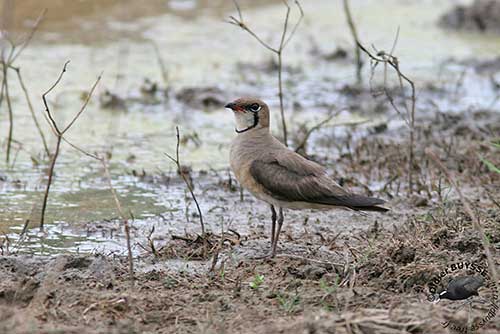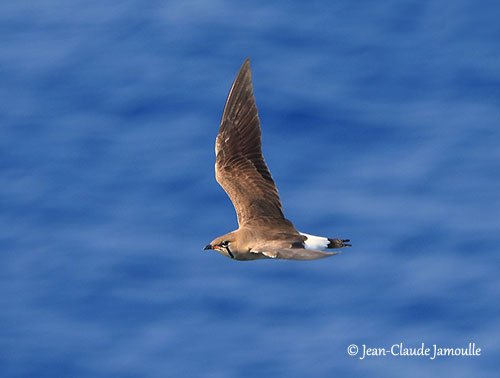
Fr: Glaréole orientale
Ang: Oriental Pratincole
All: Orientbrachschwalbe
Esp: Canastera Oriental
Ita: Pernice di mare dal collare
Nd: Oosterse Vorkstaartplevier
Sd: orientvadarsvala
Photographers:
Didier Buysse
Vision d’Oiseaux
Jean-Claude Jamoulle
A la rencontre des Oiseaux
Alan & Ann Tate
AA Bird Photography
Ingo Waschkies
Bird Photography
Text by Nicole Bouglouan
Sources:
HANDBOOK OF THE BIRDS OF THE WORLD Vol 3 by Josep del Hoyo-Andrew Elliott-Jordi Sargatal - Lynx Edicions - ISBN: 8487334202
SHOREBIRDS by Peter Hayman, John Marchant and Tony Prater – Christopher Helm – 1986 – ISBN: 0747014035
GUIDE DES LIMICOLES de D. Taylor - Delachaux et Niestlé - ISBN : 2603014080
Wikipedia, the free encyclopaedia
South Dakota Birds and Birding – (Terry L. Sohl)
What Bird-The ultimate Bird Guide (Mitchell Waite)
SORA – Behavior of a Pratincole
Malaysian Birds - Pratincole birds
BIRD ECOLOGY STUDY GROUP - Oriental Pratincole: broken wing display and vocalisation
Birds of India – Bird World - Oriental Pratincole
Oriental Pratincole
Glareola maldivarum
Charadriiformes Order – Glareolidae Family
INTRODUCTION:
The Oriental Pratincole is an atypical wader. It is often compared to swallows with its long pointed wings and deeply forked tail. In addition, it hunts insects on the wing.
This species is very gregarious and can be seen in large flocks outside breeding season.
The Oriental Pratincole has wide range in Asia and Australia. It is a long-distance migratory bird. It frequents a wide variety of habitats, usually near water. It nests in loose colonies on open plains and grassy islands in rivers.
This species is threatened by degradation and habitat loss, and locally by hunting pressure. But currently, The Oriental Pratincole is not globally threatened.

DESCRIPTION OF THE BIRD:
Biometrics:
Length: 23-25 cm
Wingspan: 46 cm
Weight: 59-95 g
The Oriental Pratincole in breeding plumage has olive-brown upperparts but rump and uppertail-coverts are white. The forked tail is white with subterminal black band. The wings are long and pointed.
On the underparts, chin and throat are buff-orange, bordered by black-and-white collar extending up to lores and base of upper mandible. The upper breast is brown, mostly rufous on lower breast, and becoming white on belly and undertail. On the underwing, the flight feathers are blackish. Underwing-coverts and axillaries are chestnut.
The bill is black with red gape. The eyes are dark brown with white crescent below. Legs and feet are blackish.
Male and female are similar.
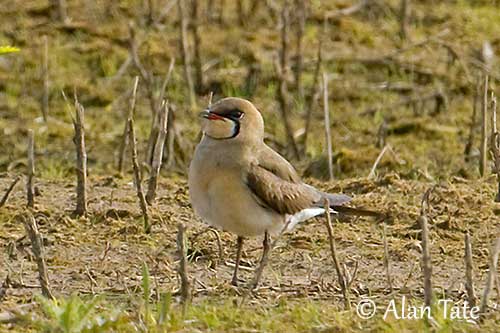
The non-breeding adult has indistinct black collar and pale buff lores, chin and throat. The brownish breast shows scaly pattern. The upperparts are dark olive-brown, slightly washed olive-green. The bill is black and lacks the red gape.
The juvenile has mottled/scaled black and buff upperparts. Throat and neck are mottled dark brown.
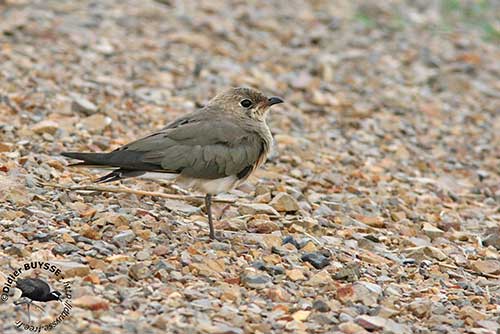
RANGE:
The Oriental Pratincole breeds in extreme S Siberia, E Mongolia and NE China, S to N India, Sri Lanka, SE Asia and Taiwan. It breeds locally in W Japan and Ryūkyū Islands. The species has also bred in S Pakistan, N Philippines and Borneo.
It winters from Maldives, India and SE Asia, through Indonesia and New Guinea to Australia.
HABITAT:
The Oriental Pratincole frequents steppes, flat lowland open grassland, dry floodplains, tidal mudflats, and sandy, pebble and shingle shorelines, freshwater and brackish water lakes. It is usually found near water.
During winter in Australia, it can be seen in open grassy plains and muddy wetlands, and occasionally on beaches and intertidal mudflats.
This species is visible up to 1,700 metres of elevation in New Guinea.
CALLS AND SONGS: SOUNDS BY XENO-CANTO
The Oriental Pratincole gives sharp “kyik” or tern-like “chick-chick” or “kirri-kirri” while flying. We can also hear a rising “trooeet”.
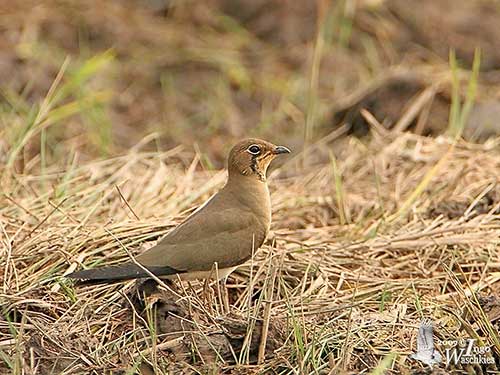
BEHAVIOUR IN THE WILD:
The Oriental Pratincole feeds primarily on insects and especially flying insects caught on the wing. It pursues the prey with fast flight, including many twists and turns before to catch the prey with its short bill.
Insects include locusts, grasshoppers, crickets, beetles, moths, dragonflies, flying ants and termites, flies, bees and wasps.
Some prey are also caught on the ground. This species is often attracted to bush fires where numerous insects gather while fleeing the fires. It feeds mainly at dusk.
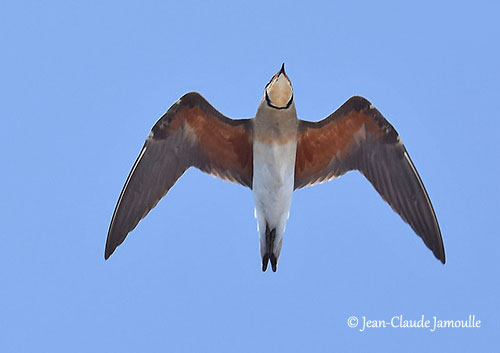
The Oriental Pratincole is seasonally monogamous. It breeds in loose colonies. The courtship display is aerial, with birds gliding with both wings raised high above the back. Other displays include head-bobbing and adapted postures to enhance the chestnut underwing.
This species is gregarious outside breeding season.
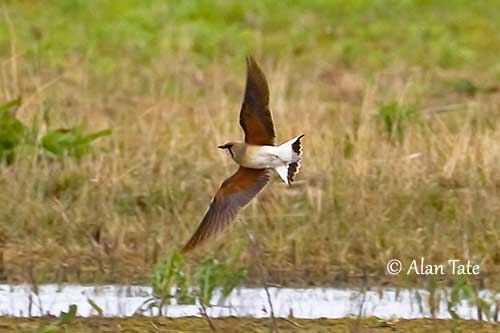
The Oriental Pratincole is migratory and travels over long distances to reach the wintering areas, especially the NE populations. They winter in SE Asia, Indonesia and Australia, between October and April. They return to their breeding areas in N from May to August.
The Indian breeding population is mainly resident, but some birds are locally nomadic or migrate over short distances.
Vagrants have reached New Zealand, Christmas Island, Cocos Islands, Mauritius and the Seychelles, but also Egypt, Arabian Peninsula, Iran, Israel, England, France, the Netherlands, Sweden, Cyprus and Turkey, and in North America, the Aleutians and St Lawrence Island. The juveniles perform post-breeding dispersions.
The Oriental Pratincole has graceful, tern-like flight. While pursuing prey, it has mostly zigzag flight on take-off, followed by direct flight with rapid wingbeats.
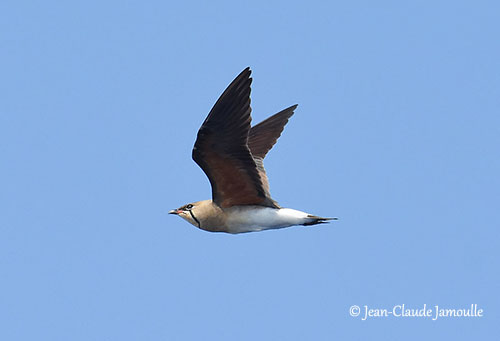
REPRODUCTION OF THIS SPECIES:
The laying occurs between April and June.
The Oriental Pratincole nests in loose colonies established on open plains and grassy islands on rivers, often with River Terns (Sterna aurantia). The nest is a scrape, a shallow depression on sandy or rocky ground.
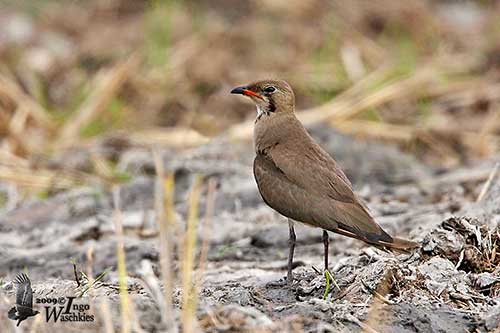
The female lays 2-3 cryptic-coloured eggs, making them almost invisible among pebbles. Both adults share the incubation during 20 days. At hatching, the chicks are buffy-white below, with darker upperparts mottled with dark brown, including on crown.
If nest or chicks are threatened by a predator, the adults perform the “broken wing display” to lead the intruder away from the nest-site.
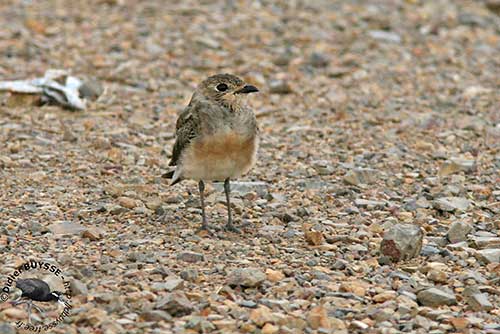
PROTECTION / THREATS / STATUS:
The Oriental Pratincole is threatened by degradation and habitat loss through cattle-grazing and agriculture expansion. Hunting in Java also affects the species. During the breeding period, nests and eggs or chicks are vulnerable to trampling by livestock grazing in the open grassy plains where this species is nesting.
The population was roughly estimated to number 2,88 million birds in February 2004, and the global estimate of 2,9/3 million individuals is applied.
The Oriental Pratincole is not globally threated and currently evaluated as Least Concern.
